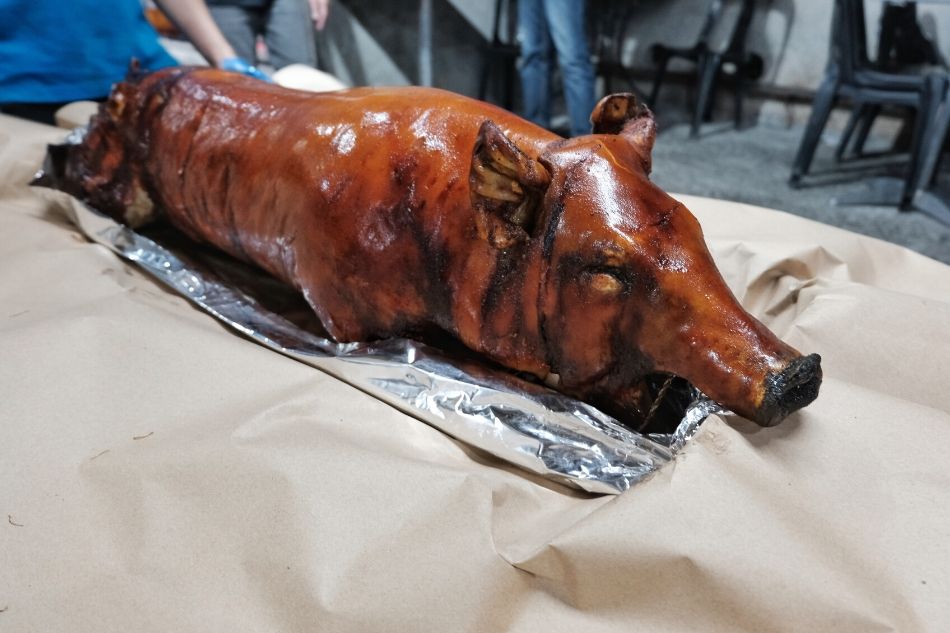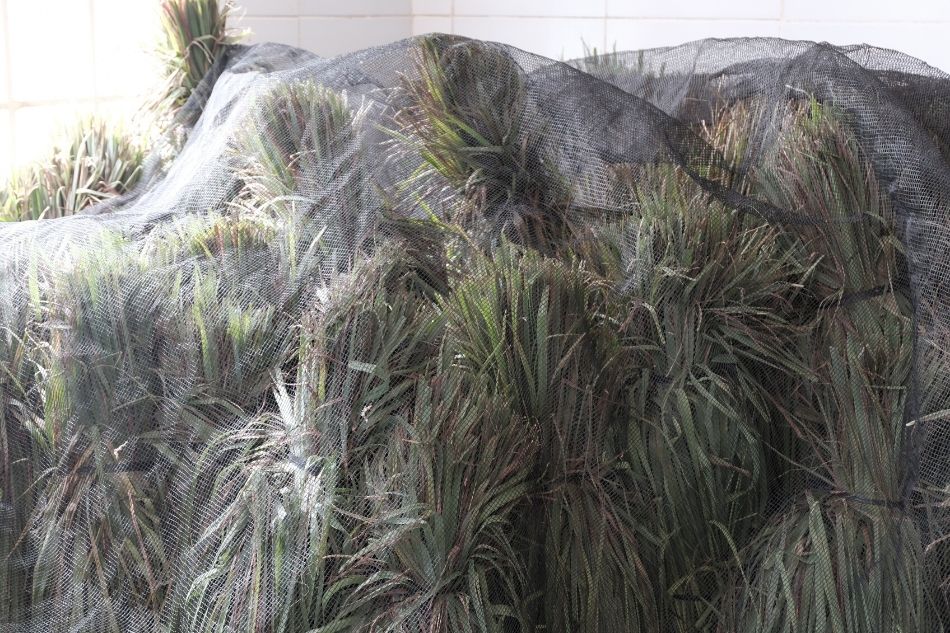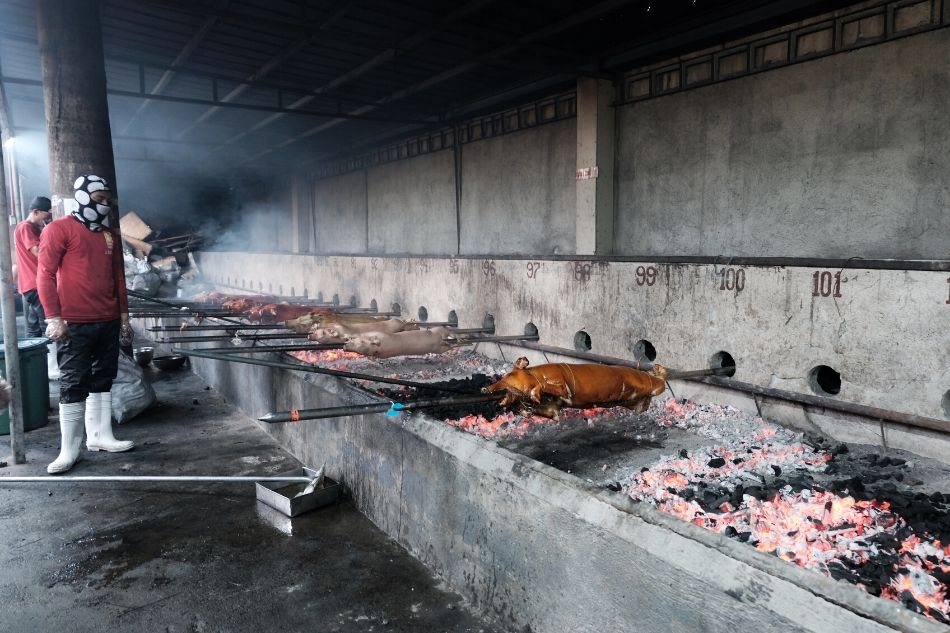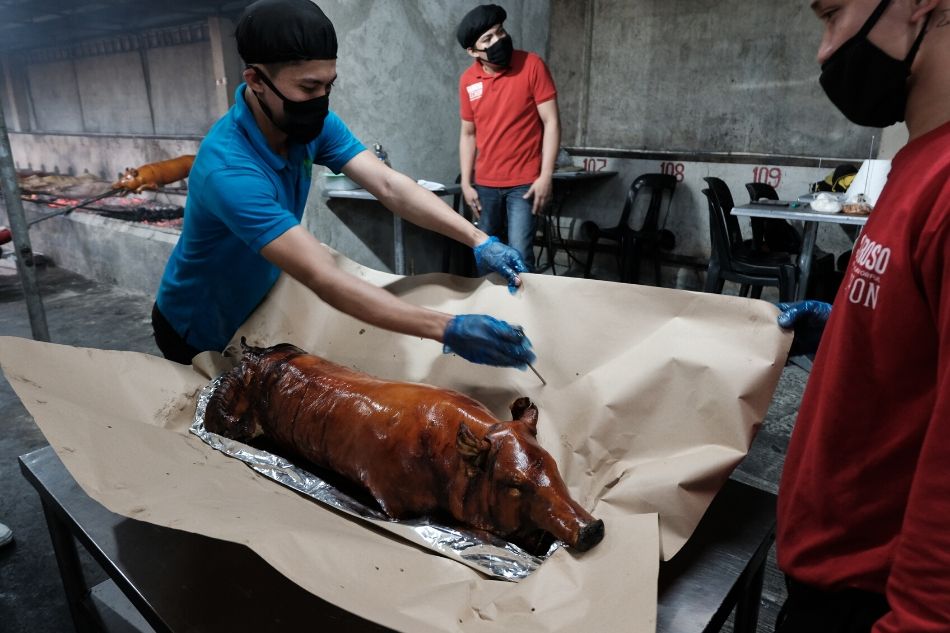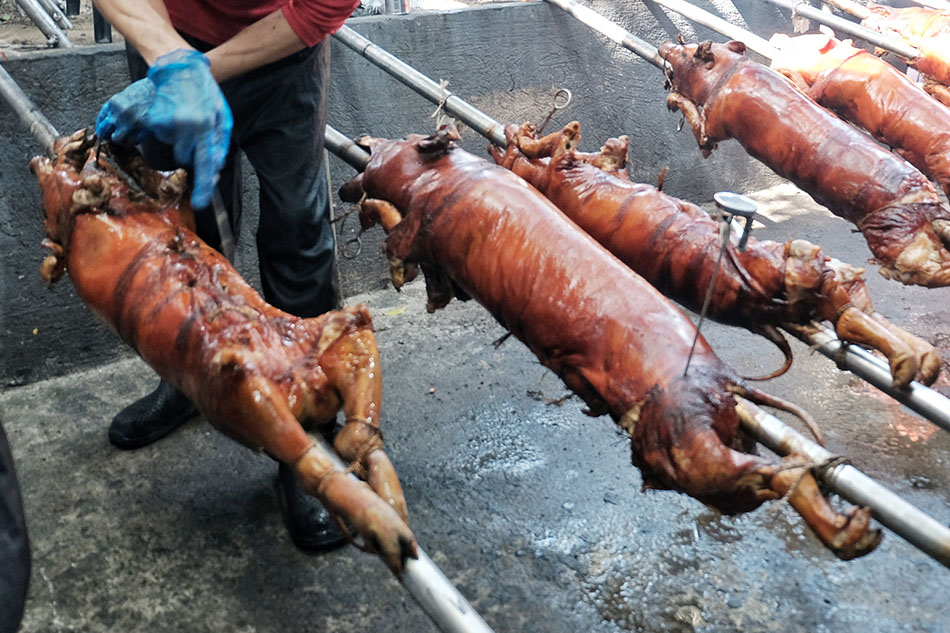For Noche Buena, you’ll want to try this Bacolod lechon stuffed with lemongrass and batuan | ABS-CBN

Welcome, Kapamilya! We use cookies to improve your browsing experience. Continuing to use this site means you agree to our use of cookies. Tell me more!
For Noche Buena, you’ll want to try this Bacolod lechon stuffed with lemongrass and batuan
For Noche Buena, you’ll want to try this Bacolod lechon stuffed with lemongrass and batuan
Maricris B. Encarnacion
Published Dec 20, 2019 03:58 PM PHT
|
Updated Dec 20, 2019 06:05 PM PHT
Lechon is the star of all festive Filipino tables and for Noche Buena. It almost always steals the thunder from Christmas ham, and rightly so. A whole roasted pig, with its shiny caramel colored skin, once cracked, releases steam and a delicious aroma that wafts through the air. Its skin is crisp and savory; its meat, succulent and sinewy. Lechon is celebratory. It’s tradition.
Lechon is the star of all festive Filipino tables and for Noche Buena. It almost always steals the thunder from Christmas ham, and rightly so. A whole roasted pig, with its shiny caramel colored skin, once cracked, releases steam and a delicious aroma that wafts through the air. Its skin is crisp and savory; its meat, succulent and sinewy. Lechon is celebratory. It’s tradition.
I grew up in Manila, thinking that there was only one type of lechon, stuffed with tamarind leaves and aromatics, served with liver sauce made from scratch. As attention turned to the country’s regional cuisines, different versions started coming to the fore. The most well-known is Cebu lechon which uses a different set of aromatics dominated by spring onions and excludes liver sauce. Now recognized as a generic term, Cebu lechon no longer has to be flown in from Cebu. It is prepared and cooked in different parts of the Philippines and touted as Cebu lechon. However, lesser known Bacolod lechon is competing for space on the table, with Sabroso Lechon taking the cudgels for the culinary charge.
I grew up in Manila, thinking that there was only one type of lechon, stuffed with tamarind leaves and aromatics, served with liver sauce made from scratch. As attention turned to the country’s regional cuisines, different versions started coming to the fore. The most well-known is Cebu lechon which uses a different set of aromatics dominated by spring onions and excludes liver sauce. Now recognized as a generic term, Cebu lechon no longer has to be flown in from Cebu. It is prepared and cooked in different parts of the Philippines and touted as Cebu lechon. However, lesser known Bacolod lechon is competing for space on the table, with Sabroso Lechon taking the cudgels for the culinary charge.
You may also like:
You may also like:
- Despite the big lechon restos, many Cebuanos still flock to their old school lechoneros
- Because it's Noche Buena time: how to make your own lechon de leche
- From laing to lechon: the Pinoy lunch Margarita Fores and co. whipped up for Martha Stewart
- What really happened behind the scenes of Netflix's 'Street Food' episode on Cebu
- Despite the big lechon restos, many Cebuanos still flock to their old school lechoneros
- Because it's Noche Buena time: how to make your own lechon de leche
- From laing to lechon: the Pinoy lunch Margarita Fores and co. whipped up for Martha Stewart
- What really happened behind the scenes of Netflix's 'Street Food' episode on Cebu
What exactly is Bacolod lechon anyway and what makes it different from the Cebu or Tagalog variety? Simply put, what distinguishes one from the other is flavor. It is all about what is stuffed in the hog. In the Bacolod version, the main aromatics are lemongrass or tanglad and batuan, a fruit found mainly on the island of Negros. It is used as a souring agent in Bacolod cuisine, its flavor distinct from other more mainstream souring agents like green tamarind used in Philippine cuisine. Jonathan Co, Commissary General Manager of Sabroso Lechon, describes its flavor thus, “Our lechon has a tangy, lemon-y aroma and flavor because of the tanglad and batuan. It is what makes it different from other lechon.”
What exactly is Bacolod lechon anyway and what makes it different from the Cebu or Tagalog variety? Simply put, what distinguishes one from the other is flavor. It is all about what is stuffed in the hog. In the Bacolod version, the main aromatics are lemongrass or tanglad and batuan, a fruit found mainly on the island of Negros. It is used as a souring agent in Bacolod cuisine, its flavor distinct from other more mainstream souring agents like green tamarind used in Philippine cuisine. Jonathan Co, Commissary General Manager of Sabroso Lechon, describes its flavor thus, “Our lechon has a tangy, lemon-y aroma and flavor because of the tanglad and batuan. It is what makes it different from other lechon.”
If you haven’t tried Negrense-style lechon or don’t realize that it’s available in Manila, you can order from Sabroso Lechon, which boasts the tag line “Bacolod’s Flavorful Lechon.” This Manila-based business was launched in 2008 when Charlie Sabroso and his friend Manolo started cooking lechon using a Bacolod recipe. They began by roasting only on weekends, taking orders for whole, as well as by the kilo; and delivering personally to family and friends. As word of mouth grew their market, they opened their first outlet at the corner of E. Rodriguez Sr. and Tomas Morato Avenues in Quezon City. Ten years later, ownership changed hands.
If you haven’t tried Negrense-style lechon or don’t realize that it’s available in Manila, you can order from Sabroso Lechon, which boasts the tag line “Bacolod’s Flavorful Lechon.” This Manila-based business was launched in 2008 when Charlie Sabroso and his friend Manolo started cooking lechon using a Bacolod recipe. They began by roasting only on weekends, taking orders for whole, as well as by the kilo; and delivering personally to family and friends. As word of mouth grew their market, they opened their first outlet at the corner of E. Rodriguez Sr. and Tomas Morato Avenues in Quezon City. Ten years later, ownership changed hands.
ADVERTISEMENT
Sabroso Lechon was bought by Fruitas Holdings Inc. in 2018, on the initiative of Lester C. Yu, founder and currently Chief Executive Officer and President of the group. Juneil Torio, Investor Relations Officer explains, “The decision to acquire Sabroso Lechon was made because, aside from the lechon being delicious, the product is present in the lives of Filipinos.” The publicly-listed company counts Fruitas Fresh from Babot’s Farm, Black Pearl, Johnn Lemon, Buko Loco, Buko ni Fruitas, De Original Jamaican Pattie, The Mango Farm, Munifico Pizzeria, Shou La Mien, and Sabroso Lechon, among its most notable brands.
Sabroso Lechon was bought by Fruitas Holdings Inc. in 2018, on the initiative of Lester C. Yu, founder and currently Chief Executive Officer and President of the group. Juneil Torio, Investor Relations Officer explains, “The decision to acquire Sabroso Lechon was made because, aside from the lechon being delicious, the product is present in the lives of Filipinos.” The publicly-listed company counts Fruitas Fresh from Babot’s Farm, Black Pearl, Johnn Lemon, Buko Loco, Buko ni Fruitas, De Original Jamaican Pattie, The Mango Farm, Munifico Pizzeria, Shou La Mien, and Sabroso Lechon, among its most notable brands.
Since its acquisition, in just over a year, Sabroso Lechon has grown from two original branches to 18 stores in the greater Manila area and even in Boracay and Caticlan in Aklan. Future plans include adding more branches in the metropolis to make Sabroso Lechon more accessible to the market.
Since its acquisition, in just over a year, Sabroso Lechon has grown from two original branches to 18 stores in the greater Manila area and even in Boracay and Caticlan in Aklan. Future plans include adding more branches in the metropolis to make Sabroso Lechon more accessible to the market.
Sabroso continues to use the original lechon recipe and except for reducing the salt, the secret blend of tanglad, batuan purée, and other aromatics remains unchanged. Improvements in the process, however, have been made, from the supply chain to delivery. Only native pigs, grown in backyards and small farms from four provinces—Quezon, Marinduque, Cagayan, and Mindoro— are used. The hogs are then transported to Manila and slaughtered in the San Juan Slaughterhouse; and because of the recent African swine flu, strict implementation of submission of permits from the Department of Agriculture and National Meat Inspection Service (NMIS) is being done. The carcasses are then put in cold storage at the Sabroso commissary in Quezon City.
Sabroso continues to use the original lechon recipe and except for reducing the salt, the secret blend of tanglad, batuan purée, and other aromatics remains unchanged. Improvements in the process, however, have been made, from the supply chain to delivery. Only native pigs, grown in backyards and small farms from four provinces—Quezon, Marinduque, Cagayan, and Mindoro— are used. The hogs are then transported to Manila and slaughtered in the San Juan Slaughterhouse; and because of the recent African swine flu, strict implementation of submission of permits from the Department of Agriculture and National Meat Inspection Service (NMIS) is being done. The carcasses are then put in cold storage at the Sabroso commissary in Quezon City.
All lechon are cooked to order. Preparation involves rubbing the hog inside and out with the secret purée, stuffing the cavity with fresh lemongrass, then allowing it to marinate for two to three hours. It is then roasted in mechanized pits that can accommodate up to 90 hogs. The number of turns per minute is pre-programmed, the lechon roasting rotisserie-style over charcoal embers, cooking time dependent on the size and weight of the pig. It is worth mentioning that Sabroso uses only charcoal that carries a Department of Environment and Natural Resources (DENR) permit and meets a specific minimum burning time. No chemicals are used to kindle the charcoal.
All lechon are cooked to order. Preparation involves rubbing the hog inside and out with the secret purée, stuffing the cavity with fresh lemongrass, then allowing it to marinate for two to three hours. It is then roasted in mechanized pits that can accommodate up to 90 hogs. The number of turns per minute is pre-programmed, the lechon roasting rotisserie-style over charcoal embers, cooking time dependent on the size and weight of the pig. It is worth mentioning that Sabroso uses only charcoal that carries a Department of Environment and Natural Resources (DENR) permit and meets a specific minimum burning time. No chemicals are used to kindle the charcoal.
The cooked lechon is allowed to rest for up to 30 minutes and during this period, “grooming” takes place. The “grooming” process is an innovation of the new owners to ensure that the skin is as perfect as possible.
The cooked lechon is allowed to rest for up to 30 minutes and during this period, “grooming” takes place. The “grooming” process is an innovation of the new owners to ensure that the skin is as perfect as possible.
It takes 6 to 8 hours for the lechon to be ready, from start to finish. On a normal day, deliveries commence at 8 am with the last lechon being dispatched at 5 pm. However, during the Yuletide season, the last lechon is delivered at 11 pm on December 24 and December 31 only, just in time for the Noche Buena table.
It takes 6 to 8 hours for the lechon to be ready, from start to finish. On a normal day, deliveries commence at 8 am with the last lechon being dispatched at 5 pm. However, during the Yuletide season, the last lechon is delivered at 11 pm on December 24 and December 31 only, just in time for the Noche Buena table.
Jonathan Co describes the operations, “We are professionalizing the way we cook lechon. All personnel are required to wear uniforms, hairnets, and masks in the production area. No smoking, no eating, and no loitering is allowed. Because of our production standards, institutions such as international luxury hotels, among them the Shangri-La hotels group, The Peninsula Manila, and Marco Polo Ortigas order daily.” Sabroso employs experienced lechoneros from Bacolod, its regular plantilla augmented with seasonal roasters for 30 days.
Jonathan Co describes the operations, “We are professionalizing the way we cook lechon. All personnel are required to wear uniforms, hairnets, and masks in the production area. No smoking, no eating, and no loitering is allowed. Because of our production standards, institutions such as international luxury hotels, among them the Shangri-La hotels group, The Peninsula Manila, and Marco Polo Ortigas order daily.” Sabroso employs experienced lechoneros from Bacolod, its regular plantilla augmented with seasonal roasters for 30 days.
Sabroso lechon comes in different sizes—De Leche, Regular, Medium, Large, XLarge, XXLarge—and is served with a rich sauce that does not include liver. Sabroso also recently introduced a boneless Lechon Belly using the same Bacolod recipe.
Sabroso lechon comes in different sizes—De Leche, Regular, Medium, Large, XLarge, XXLarge—and is served with a rich sauce that does not include liver. Sabroso also recently introduced a boneless Lechon Belly using the same Bacolod recipe.
Sabroso is still accepting orders for Noche Buena. To order, call the hotline (0920) 123-9999 or send a message through Viber or via Sabroso Lechon on Facebook. You can also visit Sabroso Lechon branches at Robinsons Magnolia, Ayala Malls Manila Bay, National Book Store Quezon Avenue, Farmers Dampa, Uno Cinquenta 150 Maginhawa Street Lifestyle Park, 233 Katipunan Avenue Cubao, E-Rodriguez Sr. GYY Building, Fairview Terraces, Market! Market!, Le Village the Lifestyle Park, Puregold Q.I Central, Aguirre Avenue, BF Homes Parañaque, Trinoma Foodchoices, Landmark Trinoma Foodcourt, Landmark Trinoma Complex, Landmark Alabang Foodcourt, Sabroso Food Centre Caticlan, and Gaisano Boracay.
Sabroso is still accepting orders for Noche Buena. To order, call the hotline (0920) 123-9999 or send a message through Viber or via Sabroso Lechon on Facebook. You can also visit Sabroso Lechon branches at Robinsons Magnolia, Ayala Malls Manila Bay, National Book Store Quezon Avenue, Farmers Dampa, Uno Cinquenta 150 Maginhawa Street Lifestyle Park, 233 Katipunan Avenue Cubao, E-Rodriguez Sr. GYY Building, Fairview Terraces, Market! Market!, Le Village the Lifestyle Park, Puregold Q.I Central, Aguirre Avenue, BF Homes Parañaque, Trinoma Foodchoices, Landmark Trinoma Foodcourt, Landmark Trinoma Complex, Landmark Alabang Foodcourt, Sabroso Food Centre Caticlan, and Gaisano Boracay.
Photos by Chris Clemente
ADVERTISEMENT
ADVERTISEMENT


